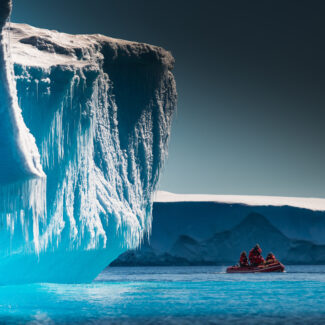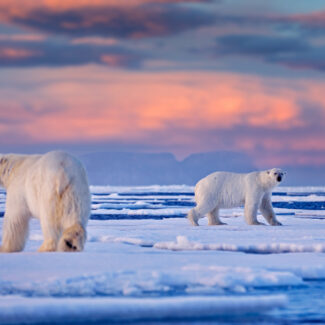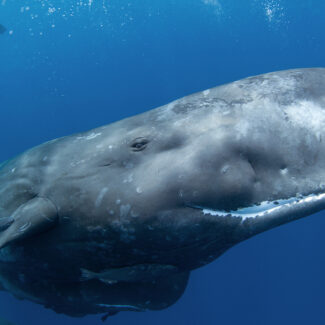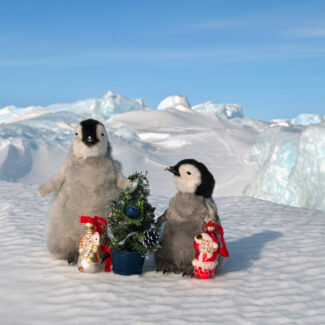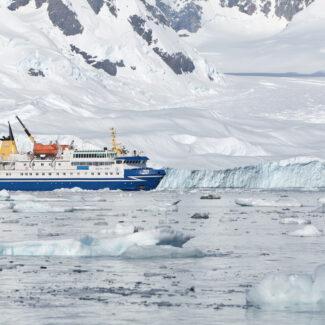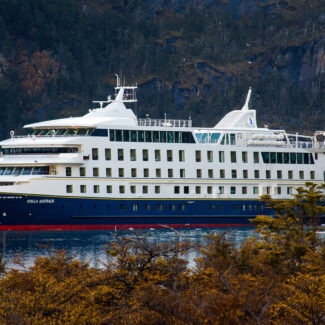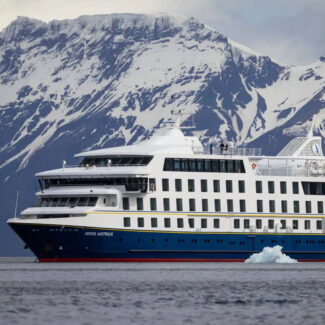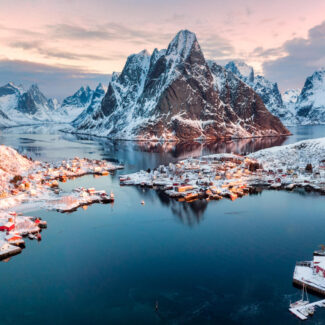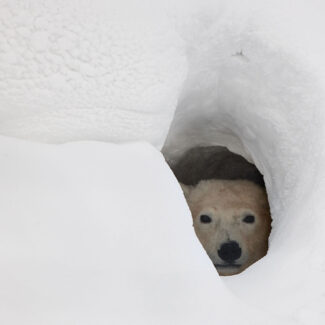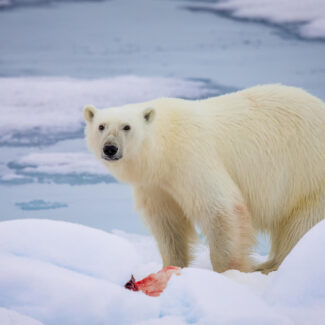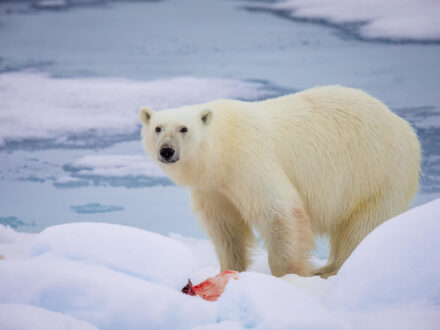6 Astonishing Arctic Tern Facts: Meet The Matchless Migrator
- (1) They Make the Longest Known Annual Migration of Any Creature on Earth
- (2) Their Breeding Range Extends South Into Northern Temperate Regions
- (3) They’re a Long-Lived Bird
- (4) They Feed on Everything From Krill to Small Fish
- (5) They’re Aerial Athletes (and Fierce Nest-Defending Divebombers)
- (6) Scientists Are Exploring How Climate Change & Other Anthropogenic Impacts May Be Affecting the Arctic Tern
- Where to See Arctic Terns
The Arctic tern is certainly a handsome bird, suited up as it is with a black cap, a slim feathery suit of gray and white, and a sharp, shortish bill that changes color between black (non-breeding) and red (breeding) over the course of the year. Yet to glance at this small, dapper, scimitar-winged seabird, you likely wouldn’t appreciate what an absolutely superlative wayfarer it is, beating its way over tens of thousands of miles on an annual basis as it commutes between Arctic and Antarctic hangouts.
Yes, you read that right: The Arctic tern, name notwithstanding, is just as much a creature of the bottom of the world as the top. It essentially lives its life riding an eternal summer: the boreal summer up in the Arctic and subarctic, its breeding season, and the austral summer down in the Antarctic, where it “winters” on the pack ice. Few migratory patterns are so astonishing; none cover such mileage.
Herein, we’ve rounded up some of the standout Arctic tern facts—plus a little insight into where you might be able to clap eyes on this absolute powerhouse of a globetrotter on an Arctic cruise!
(1) They Make the Longest Known Annual Migration of Any Creature on Earth
The “world’s migration champion”: That’s how Wells Woodbridge Cooke described the Arctic tern way back in 1915, in his tract Bird Migration. And, indeed, no other animal makes such a lengthy back-and-forth migration every year than this seabird, whose annual journey between the Arctic/sub-Arctic and the Antarctic tallies (depending on the population) to anywhere from about 37,000 to 51,000 miles (60,000 to 82,000 kilometers) round-trip.
Several major flyways funnel Arctic terns of different populations from pole to pole (roughly speaking), with, for example, southbound routes along the western coast of the Americas and down the western coasts of Europe and Africa. Some terns following the East Atlantic flyway commonly cut across the Indian Ocean to Australia and New Zealand before reaching Antarctica. The Indian Ocean as well as such resource-rich hotspots as the Benguela Current, the North Atlantic, the California Current, the Humboldt Current, and the Patagonian Shelf appear to be important staging grounds along various Arctic tern migration routes: not only providing productive feeding opportunities, but also, for southbound fall migrants, the chance to dally a bit while the Antarctic pack ice develops into an auspicious springtime state. Terns typically arrive in the Antarctic by October or November and then commence an annual molt.
While Arctic terns may spend several months on their post-breeding season southbound migration, and upwards of 4.5 months wintering in the Antarctic (the Weddell Sea being a particularly important wintering ground), their northbound springtime journeys can be swift indeed: a mere 40 days or so, according to tracking research on the Greenlandic, Dutch, and Baltic populations. Two major northbound flyways exist in the Pacific and the Atlantic basins, generally situated farther offshore than the more coast-hugging southbound routes.
Witness the incredible journey! This massive flock of Arctic Terns embarks on the longest annual migration of any creature on Earth, covering staggering distances from pole to pole. Truly matchless migrators.
(2) Their Breeding Range Extends South Into Northern Temperate Regions
Although Arctic terns definitely nest in the Far North—all the way up into the Canadian Arctic Archipelago, Greenland, northern Alaska, and the Arctic coast and offshore archipelagos of Eurasia—their breeding range also extends quite far south. They nest, for example, in the British Isles, the northern seacoast of Germany, and down the North American Atlantic seashore as far as Cape Cod, Massachusetts. In such places they may form mixed breeding colonies with the very similar-looking common tern as well as the least tern.
Arctic terns are ground-nesting birds that prefer open and often rocky ground near coastlines for rearing their single annual broods.
While renowned for their polar migrations, Arctic terns also extend their breeding range into more temperate northern regions, nurturing new life in diverse landscapes. A testament to their incredible adaptability!
(3) They’re a Long-Lived Bird
The oldest documented Arctic tern, identified during a bird-banding effort in Maine, was an impressive 34 years old. Taking into consideration the immense round-trip migratory journeys this species executes, it’s likely this venerable tern had covered something like an equivalent distance to several there-and-back commutes to the Moon.
The relatively long Arctic tern lifespan somewhat bucks the general biological pattern of smaller-bodied, higher-metabolism organisms having shorter lives than bigger organisms with slower metabolisms.
Meet a true survivor! Arctic terns are remarkably long-lived birds, enduring their epic migrations year after year. This “Matchless Migrator” is a testament to resilience and longevity in the avian world.
(4) They Feed on Everything From Krill to Small Fish
Smallish fish, from capelin and herring to smelt and sandeels, form a firm foundation for the Arctic tern diet, as does krill: important sustenance during the tern’s Antarctic residency, when the birds deplete energy stores following their southbound migration. Other common foods include shrimp, marine worms, and both flying and ground-based insects.
Arctic terns—often in company with a whole variety of other seabirds—will readily key into the hunting of predatory fish such as tuna as well as marine mammals such as dolphins, porpoises, and seals, which drive baitfish toward the surface and within reach of feathered strikers. Such near-surface “baitballs” are certainly much appreciated by Arctic terns, which are shallow plunge-divers (as compared to deep plungers such as northern gannets and pursuit divers such as puffins, cormorants, and razorbills).
An Arctic Tern carries its catch in flight. These remarkable birds have a varied diet, from krill to small fish, sustaining them on their long journeys.
(5) They’re Aerial Athletes (and Fierce Nest-Defending Divebombers)
It may be stating the obvious to note that Arctic terns, those epic travelers, are strong, graceful, and agile flyers. They employ a variety of hunting methods to snatch prey, including the aforementioned plunge-diving into the uppermost part of the water column, plucking fodder from the surface or just beneath it, and even snatching insects on the wing.
Their aerial agility aids them when trying to outmaneuver airborne kleptoparasites such as gulls, and when they’re defending their ground-based nests: They’ll dive-bomb nearly any creature that strays too close, humans very much included. Inuit people have traditionally exploited Arctic tern eggs for food, and they’re also targeted by Arctic foxes, jaegers, ravens, and a variety of other non-human raiders, so the active nest defense certainly makes sense!
With remarkable agility, Arctic terns navigate the skies, as seen at sunset. Their aerial prowess is key to their survival, showcasing their role as proficient “aerial athletes.”
(6) Scientists Are Exploring How Climate Change & Other Anthropogenic Impacts May Be Affecting the Arctic Tern
The Arctic tern has great ecological significance as well as cultural meaning and resource value for indigenous peoples of the Arctic and sub-Arctic. Inuit observations of declining breeding colonies of Arctic terns in some areas reflect a probable downslide in the global population of this species: a worrisome trend scientists are still trying to better quantify, not necessarily an easy task given the bird’s vast range and often-remote haunts.
Along with such factors as marine pollution and overfishing and bycatch, Arctic terns are surely contending with our warming climate, which is shifting ecosystem dynamics across the entirety of the tern’s one-end-of-the-Earth-to-the-other domain. Those shifting dynamics include declines in sea ice and associated changes to the marine food web in both the Arctic and Antarctic (though the sea-ice patterns we’re observing in Antarctica are not uniform). Climate change may also change the strength and potentially direction of winds, which might have impacts on Arctic terns during their transhemispheric migration, as their flyways take advantage of tailwinds, crosswinds, and other favorable airstreams.
As these “Matchless Migrators” rest by the water, scientists are studying how climate change and human activities may impact Arctic tern populations, highlighting the need for conservation efforts.
Where to See Arctic Terns
Summer cruises just about anywhere in the Arctic could yield sightings of Arctic terns on their coastal nesting grounds and foraging over open water. What a special thrill it is to eyeball this unrivaled traveler of an Arctic bird, chasing the Midnight Sun from one side of the planet to the other!
Disclaimer
Our travel guides are for informational purposes only. While we aim to provide accurate and up-to-date information, Antarctica Cruises makes no representations as to the accuracy or completeness of any information in our guides or found by following any link on this site.
Antarctica Cruises cannot and will not accept responsibility for any omissions or inaccuracies, or for any consequences arising therefrom, including any losses, injuries, or damages resulting from the display or use of this information.


